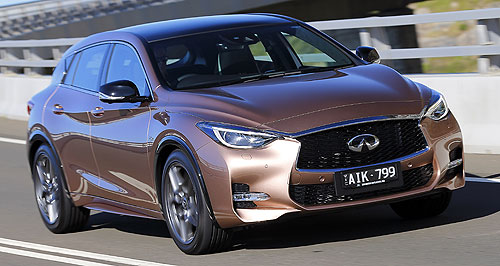Driven: Infiniti Q30 crosses over
BY TIM ROBSON | 26th Aug 2016

The luxury car brand minnow is pinning its hopes on its new car, which will be positioned as a small SUV, as well as its soon-to-be-released all-wheel-drive twin, the QX30.
“It’s not a make or break car (for the brand),” said Infiniti Cars Australia managing director Jean-Philippe Roux of the Q30, “it’s a milestone. From a volume perspective, it’s the most important car (in our range).” With just seven dealers and two service centres currently in play around the country, Mr Roux said he believed that the product catalogue needed to come first before the brand’s presence could be properly rolled out.
“We haven’t been sitting here doing nothing,” he said. “We have been quiet recently, but we think these are the cars that will work for Australia.” He acknowledges that the brand still has some way to go to cut through the crowded local market, but says the brand – a part of the Renault-Nissan Alliance – is in it for the long haul in Australia.
“The recognition is not where it needs to be yet,” he said. “We still have a lot of work to do.” Infiniti insists that the Q30 isn’t a hatch, and should be compared with vehicles like the Audi Q3, BMW X1 and even the Mercedes-Benz GLA upon which it is largely based.
Its physical dimensions are even an exact match for those found on the GLA, measuring 4225mm long, 2083mm wide and 1495mm high in base spec or 1475mm in sporting guise.
It will also compete against cars such as the Audi A1, BMW 1 Series and Volvo’s V40.
The Q30, which is built at Nissan’s Sunderland plant in the United Kingdom, is part of a wider technology sharing deal between Renault-Nissan and Daimler, with the small car sitting atop the Modular Front Architecture (MFA) platform that underpins the Mercedes-Benz A-Class range and using the brand’s engines.
Mr Roux said he does not believe customers will take much notice of the product sharing aspect of the car’s design.
“It’s a big deal for us (in the industry),” he argued, “but for Mr and Mrs Smith? I’m not so sure.” Launching this month, the Q30 will be offered in three variants the 1.6-litre turbocharged four-cylinder GT, the 2.0-litre turbocharged four-cylinder Sports and similarly powered Sports Premium.
A 2.1-litre turbo-diesel engine is also offered in the Sports and Sports Premium variants.
Based around a front-wheel-drive/seven-speed dual-clutch transmission drivetrain layout, the Q30 GT will kick off the range at $38,900 plus on-road costs.
The entry price is about $1700 dearer than the opening price for the A-Class, but the powertrain lines up with the next variant up in the Benz line-up, the $42,800 A200.
Its Mercedes-Benz sourced 1.6-litre turbo-petrol four-potter makes 115kW at 5300rpm and 250Nm at 1250rpm, and returns a combined fuel consumption average of 6.0 litres per 100km. It emits 139 grams of CO2 per kilometre.
It comes standard with a cloth interior trim with manually adjustable seats, 18-inch alloys, halogen headlights and LED tail-lights, single-zone climate control, automatic headlights and wipers.
It also scores a 7.0-inch touchscreen that offers phone connectivity, leather-wrapped steering wheel, heated side mirrors, a pair of USB ports and a high-spec alarm with interior motion sensor.
Safety wise, the five-star ANCAP-rated Q30 gets seven airbags, auto emergency braking and a pop-up bonnet as standard.
It does, however, miss out on a reversing camera, making do with rear-only sensors.
The GT rides 15mm higher than the other cars in the range, with Infiniti claiming each grade features a bespoke suspension tune that accounts for the additional weight of larger engines and extra standard equipment.
The Sports – recognisable via a set of 19-inch rims, different front and rear bars, a lower ride height and a small ‘S’ badge – gains a larger engine and more standard equipment, and jumps $6,000 in price to retail at $44,900 before on-road costs.
A Benz-sourced 2.0-litre turbocharged four-cylinder petrol engine that produces 155kW at 5500rpm and 350Nm at 1200rpm powers the Sports. It returns a claimed 6.3L/100km on the combined fuel cycle and emits 147g/km of CO2.
Its interior is based largely on that aboard the A-Class range, though a bespoke dash binnacle and unique seats, along with additional leather and Alcantara trim, set the two apart.
Leatherette and Alcantara-accented heated sports seats, an idle-stop system, a D-shaped wheel, self-levelling LED headlights with cornering function and high-beam assist, lane departure warning and traffic sign recognition are included as standard.
The sign recognition system has been calibrated to read roadside speed signs, flashing the result up in the centre TFT display on the dash.
Stepping into the $52,900 Sports Premium nets the Q30 buyer a glass sunroof, a Bose 10-speaker stereo (a $1000 option on the Sports), radar cruise, intelligent brake assist, intelligent park assist, a four-camera around-view monitor, moving object detection and Nappa leather-appointed powered seats over the Sports.
Both the Sports and Sports Premium can be optioned with the 125kW/350Nm 2.1-litre turbo diesel four-potter, which returns 5.2L/100km and emits 120g CO2/km.
It costs $46,900 for the Sports diesel and $54,900 for the Sports Premium, representing a $2000 uptick.
2016 Infiniti Q30 pricing*
| 1.6t GT (a) | $38,900 |
| 2.0t Sports (a) | $44,900 |
| 2.2d Sports (a) | $46,900 |
| 2.0t Sports Premium (a) | $52,900 |
| 2.2d Sports Premium (a) | $54,900 |